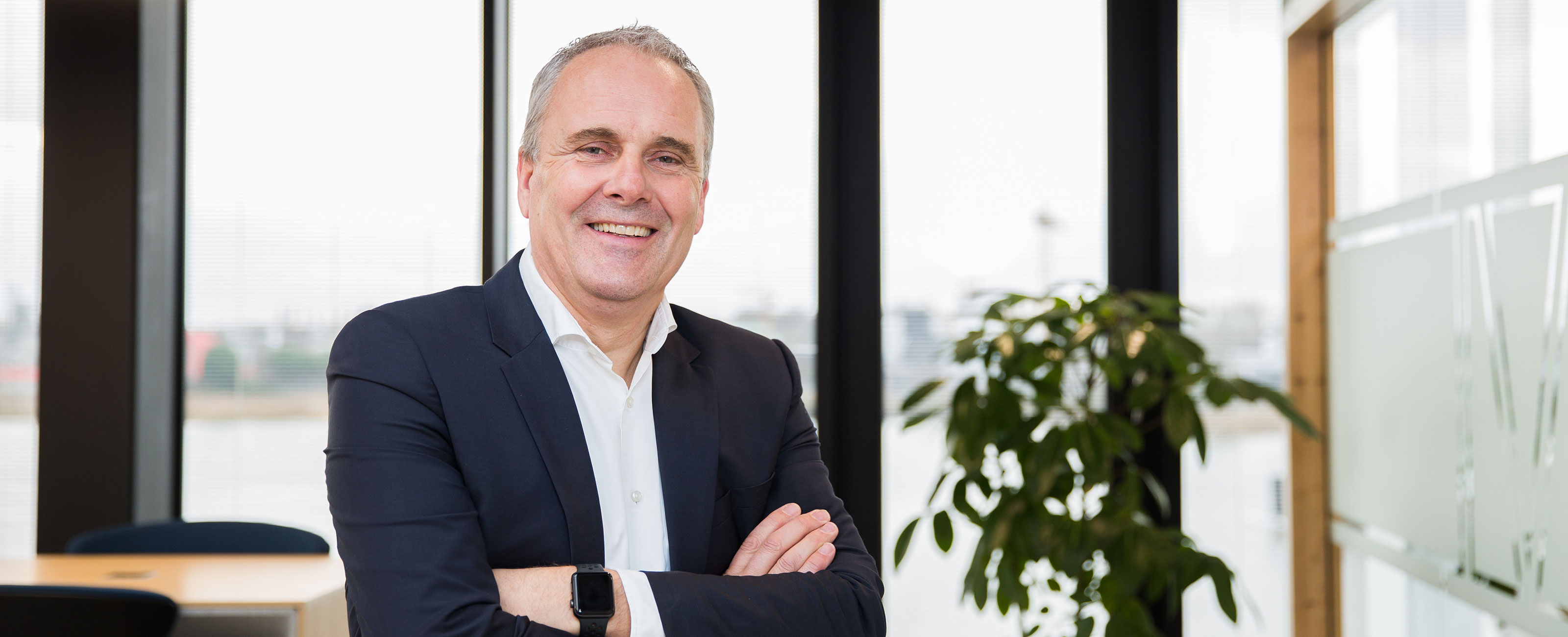Arjen Dekker on Slob Shipyard
'Together we achieved the best possible result'
“A fine, functional building.” That’s the sober assessment by general director Arjen Dekker of the new office building for Slob Shipyard in Papendrecht.
Wonderfully situated along the Beneden Merwede waterway, with two sides overlooking the water, this structure made of steel, glass and concrete houses a business that works hard on the design and construction of large yachts. There’s a no-nonsense attitude about the company, which builds hulls for the world’s most luxurious super-yachts. And that attitude is certainly true of the director. Even so, one detects a note of pride in his words. “We have the finest building in the sector. I receive nothing but compliments.”
For years, this site was occupied by construction trailers: temporary looking primitive structures that housed the people who design, detail and build the most luxurious yachts on earth. Then there came a moment when the local authority had had enough: the temporary units occupied by Slob Shipyard had to go. Architect Vincent Ketting – then a new partner at EGM – first designed a scheme that the shipbuilder himself could build, like the prow of a ship, with shapes that referenced the big yachts being constructed in the halls next door. That turned out to be slightly too ambitious. Not only in terms of shape and appearance but also the idea of ‘building it ourselves’ was ditched. So he came up with a new design, businesslike in appearance with sturdy materials that were more appropriate to the industrial character of the site. The large amount of glass in the facade ensures stunning views.
Holding onto basic qualities
“The period when we had to tender and construct was not favourable for the project,” explains Arjen Dekker, in his office on the second floor, with that wonderful view of the Beneden Merwede. “The project was developed at the tail end of the crisis, but by the time construction started, conditions had suddenly changed. We had to amend the design significantly, largely for budgetary reasons.” That involved intensive collaboration between the client and architect to safeguard the essential qualities of the project. Dekker: “The budget was fixed, the design had been approved. Together with EGM, we achieved the best possible result. I really have to give credit for that to the architecture firm, because they achieved so much despite the budget limitations. The concept has survived intact.”
Together with EGM, we achieved the best possible result.
Shipbuilding is more digitalized
During the development and construction of the office building, Dekker was astonished by the many procedures involving local authorities, the construction management, and the state of digitalization in construction. “Construction clearly lags behind when it comes to digitalization in design and management. Our shipbuilding sector is streets ahead.” He walks to a screen where all ship components – in terms of construction and installation – are drawn and defined at the same time. “This digital model is also used to work out the construction logistics. That’s an extremely precise process.”
Like in the construction industry, each design in the luxury shipping sector is a unique specimen, built only once. “But in the construction of our office building, I didn’t see that happening in the integrated way we do it,” concludes the shipbuilder. Nonetheless, he is full of praise about the parties that carried out the work: the contractors, the electricians. “When you make a promise, keep it. That’s certainly true of everybody who worked with us on this building,” notes Dekker happily.
Building invites collaboration
The optimization of operating processes for the eighty occupants of the office building was certainly a crucial factor during the design. “The floor plans are efficiently laid out, with all the necessary tools and access to the systems through continuous cable trays. The building is full of smart things!” On every floor there is a corner where you can grab a coffee. But most employees have to walk a bit to reach the printer. Dekker: “That’s healthy, because it ensures people move a little. The furnishing of the work areas, with a stand-sit table at each workstation, also supports philosophy.”
The optimization of operating processes for the eighty occupants of the office building was certainly a crucial factor during the design.
The ceremonial steel stairs at the entrance is a product from our own workshop: “Our workers welded it from shipbuilding elements, just like the reception desk.” These sturdy-looking elements contrast nicely with the smooth glass and concrete planes of the building. “Our staff are happy with the new building, also because they recognize elements of their own work in it. This building invites collaboration, and we’ve seen that happen in the months since we moved in,” says a contented shipbuilding director. The days of temporary units placed next to the production halls are gone. “This building relates much more closely to the product we make. High-quality designs, unique products.” In other words, it’s a fine and a functional calling card.
Caroline Kruit, journalist and publisher, interviewed Arjen in March 2019
Project: Shipyard Slob

